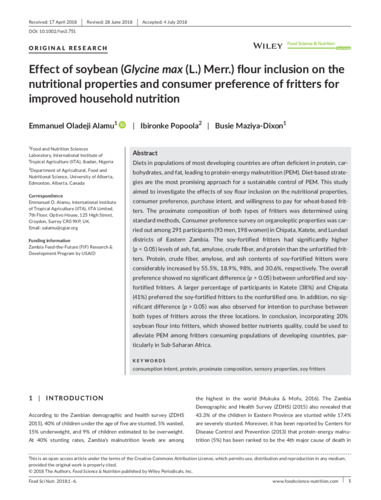Effect of soybean (Glycine max (L.) Merr.) flour inclusion on the nutritional properties and consumer preference of fritters for improved household nutrition
Abstract
Diets in populations of most developing countries are often deficient in protein, carbohydrates, and fat, leading to protein‐energy malnutrition (PEM). Diet‐based strategies are the most promising approach for a sustainable control of PEM. This study aimed to investigate the effects of soy flour inclusion on the nutritional properties, consumer preference, purchase intent, and willingness to pay for wheat‐based fritters. The proximate composition of both types of fritters was determined using standard methods, Consumer preference survey on organoleptic properties was carried out among 291 participants (93 men, 198 women) in Chipata, Katete, and Lundazi districts of Eastern Zambia. The soy‐fortified fritters had significantly higher (p < 0.05) levels of ash, fat, amylose, crude fiber, and protein than the unfortified fritters. Protein, crude fiber, amylose, and ash contents of soy‐fortified fritters were considerably increased by 55.5%, 18.9%, 98%, and 30.6%, respectively. The overall preference showed no significant difference (p > 0.05) between unfortified and soy‐fortified fritters. A larger percentage of participants in Katete (38%) and Chipata (41%) preferred the soy‐fortified fritters to the nonfortified one. In addition, no significant difference (p > 0.05) was also observed for intention to purchase between both types of fritters across the three locations. In conclusion, incorporating 20% soybean flour into fritters, which showed better nutrients quality, could be used to alleviate PEM among fritters consuming populations of developing countries, particularly in Sub‐Saharan Africa.

